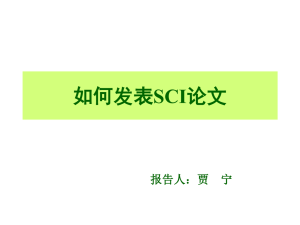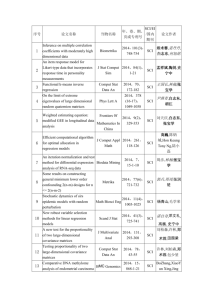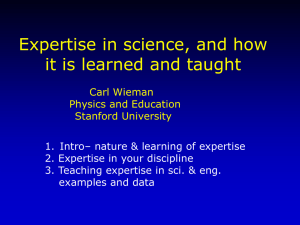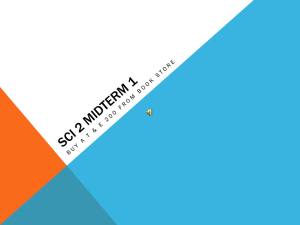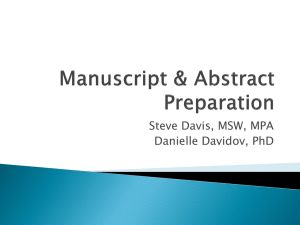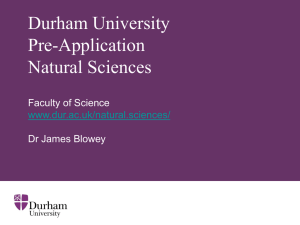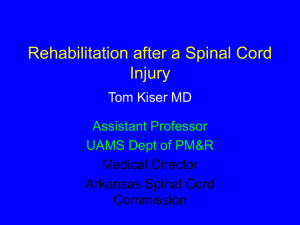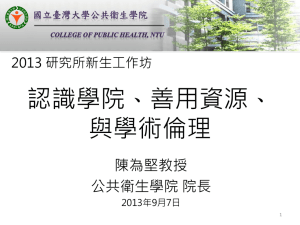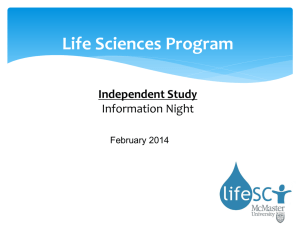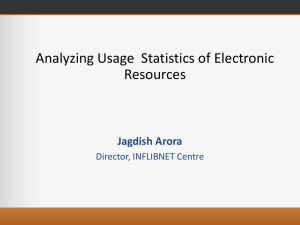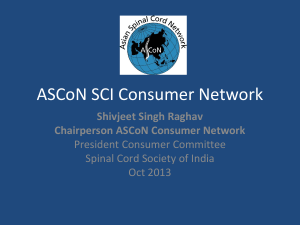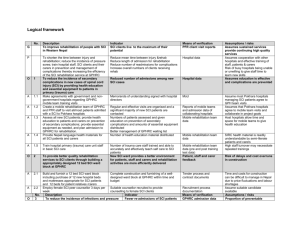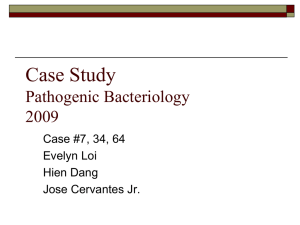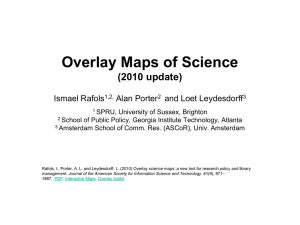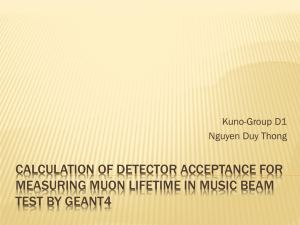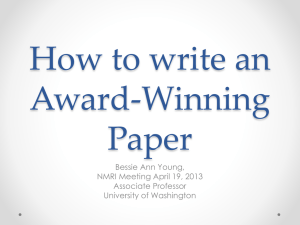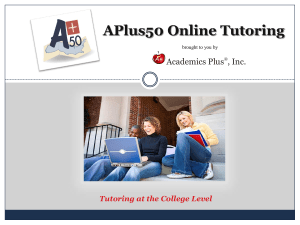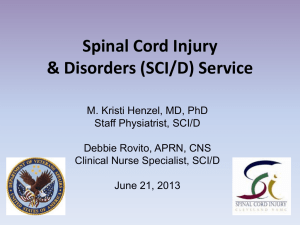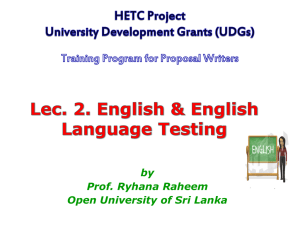刘延秀 - 上海外语教育出版社
advertisement
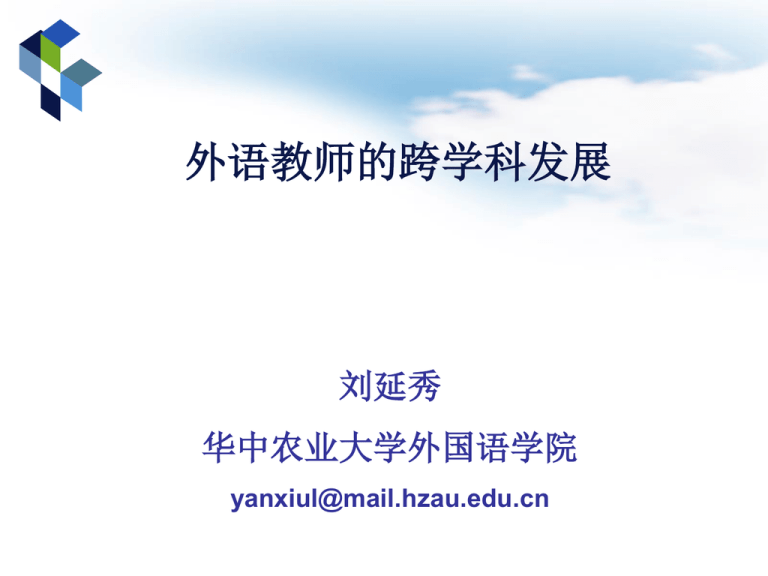
外语教师的跨学科发展 刘延秀 华中农业大学外国语学院 yanxiul@mail.hzau.edu.cn Contents 1 问题的提出 2 外语教师跨学科发展的潜力 3 外语教师跨学科的发展方向 4 指导SCI论文写作的探索 1 问题的提出 ◇ 外语教师目前承担的工作 ◇ 外语教师面临的压力和挑战 ◇ 外语教师的发展前途 ◇ 外语教师目前承担的工作 课堂教学 1. 大学英语 英语读写,英语口语,计算机辅助自主学习 通识课程(文学类,文化类,ESP) 2. 研究生英语 英语阅读,英语听说,学术英语(EAP) 3. 英语专业课程(语言、文学、翻译及商务 英语专业) ◇外语教师面临的压力和挑战 1. 教学改革势在必行 1)计算机辅助自主学习,口语,分级教 学以及各种教学模式创新 2)学习者的厌学 面对见不着水的旱鸭子和“不喝水的牛” 强行按头(张文忠,2011) 3)各高校教育改革中减少学时的压力 4)社会对于外语教学的多种贬低之词 2. 个人事业与学术发展 1)认清外在形势和自身条件 需要认清高等教育的发展形势和自身条件, 准确定位,提高自身的综合素质和专业素质, 走专业化可持续发展之路(张文忠,2011) 外在形势:对英语教学改革的呼声日益高涨 自身条件:外语专长、西方文化、教学经验 2)必须具备两类知识 - 教师的技术性知识(学科知识) 学科知识是一种普遍性知识,指对于目的语的 知识和能力。 - 教师的实践性知识 (教学体验知识) 教学体验是受环境制约的。(吴一安,2008) 3)坚持知识和能力的可持续发展 转型-攻艰-创新-发展 助人自我发展的能力 (夏纪梅,教育部改革巡讲团巡讲) ◇ 外语教师的发展前途 1) 改革教学内容 CBI Content Based Instruction 将英语知识和技能同人文知识结合 英美文化,文学欣赏,影视欣赏,中西方文化对比等 ESP(English for Specific Purpose) 将英语知识与某种能力结合 语言类和专业英语类课程 EAP (English for Academic Purpose) 将英语知识与某个专业知识结合 计算机英语,国际学术会议与交流,学术论文写作等 ECDT (English for Cross-discipline Tutoring ) 跨学科指导学生的专业学术研究论文写作 2) 改革教学形式 课堂形式 小班授课, 任务型研讨等等 课外形式 论文语言导师 ECDT (English for Cross-discipline Tutoring ) 2 外语教师跨学科发展的潜力 外语教师已经具备的条件 一个基本功,二个能力 扎实的外语基本功 较强的语用能力 敏锐的接受新事物的能力 外语教师跨学科指导的可行性 “科学”的主编,Bruce Alberts说,他们每年都收到万余篇 申请发表的专业论文,而“中国学者的论文退稿率比较高” 。 《科学》杂志更青睐研究方向较广、视角新颖的创新型论文 ,但中国学者的不少文章不太符合要求。“一些中国科学家 做研究的时候总显得很保密,不喜欢与他人交流。” Alberts还说,在这点上国外学者的开放态度值得学习。 “适当的学术探讨不仅能启发新思路,也能避免不必要的重 复研究。” 部分导师自身英语水平和工作的制约。 SCI论文就是毕业的保证。就是职称的保证, 就是获得奖励的保证。 3 外语教师跨学科的发展方向 语言、文学类 ESP (English for Specific Purpose) EAP (English for Academic Purpose) ECDT (English for Cross-discipline Tutoring ) ECDT (English for Cross-discipline Tutoring ) ECDT English Sciences 4 指导SCI论文写作的探索 ECDT的指导对象 ECDT的指导内容 ECDT指导模式 学术论文写作课程的指导方法 “学术写作工作室”的指导方法 取得的成果 问题与结论 ECDT的指导对象 在校博士、硕士 高校社科、自然学科教师 研究院所研究人员 ECDT的指导内容 SCI论文 SCI: Science Citation Index 科学索引 - created in the Institute for Scientific Information 美国资讯研究所 by Eugene Garfield in 1960 to Thomson Scientific (Group), 进入SCI系统的刊物分为两类,前者的影响 因子高于后者,前者称为SCI刊物,后者称 为SCIsearch刊物。 SCI从来源期刊数量划分为SCI和SCI-E。 SCI指来源刊为3700多种的SCI印刷版和SCI 光盘版(SCI Compact Disc Edition, 简 称SCI CDE), SCI-E(SCI Expanded)是SCI的扩展版 Total journals covered until 2011: SCI: 2011搜集3786 , 2012搜集3750 SCI-E 2011年搜集8288,2013年搜集8411 SCI Sources (only for your reference) 印刷版(SCI),双月刊,3,500种 联机版(SciSearch),周更新,5,600种 光盘版(带文摘)(SCICDE),月更新, 3,500种(同印刷版) 网络版(SCIExpanded),周更新,5,600 种(同联机版) 进入SCI这一类刊物的论文即为SCI论文。 SCI Impact Index/Factor 影响因子 在一定时期(通常是前两年)内,某一刊 物发表的论文,被已经进入SCI刊物的论 文所引用的总次数,除以该刊物这一时期 内的论文总数,即为该刊物的影响因子。 More Indexes SSCI: Social Science Citation Index 社会科学引文索引, - created in 1969, Total journals covered until 2011: 2,929 EI: 工程索引 - created in 1884 年 by Elsevier Engineering Information Inc. ISTP: Index to Scientific & Technical Proceedings 科技会议录索引 It was created in 1978 年 by Institute for Scientific Information 美国科学情报研究所 It collects documents from conferences. Webside: http://scientific.thomson.com/produ cts/istp ISR: Index to Scientific Reviews 科学评论索引 Webside: http://scientfic.thomson.com/produ cts/isr PCI: Patent Citation Index 专利引用索引 Webside: http://scientfic.thomson.com/produ cts/ahci ECDT的指导模式 写作工作室 写作课程 ECDT Text 1. 学术论文写作课程 学时: 24学时 形式: 课堂教学 教学内容: 1)英语语言知识 ( 遣词、句子结构、语言文化、语义衔接、 逻辑组织) 2) 学术论文写作知识 (论文框架、论文内容、写作技巧、书信) 1)英语语言知识 e.g. 1. Ignoring the verb-object match 2. Ignoring the functions of words 3. More repetition 4. Using words in a subjective mood 5. Preferring noun and noun phrases 6. Choosing words incongruous in meaning (不一致) 7. Confusing the words with –ed and –ing 8. Other problems The shortage of traditionally inactive vaccine was obvious. The improvement of availability of phosphorus in soils is one of the important conditions for increase in rape seedling production. We identified a number of altered proteins in the virus infected chicken brain tissues compared to the uninfected brain tissues. Therefore, the development of a highly sensitive and specific QDs-basedfluoroimmuno assay will be extremely useful for detection of influenza virus. 2) 学术论文写作知识 1) 2) 3) 4) 5) 6) 7) 8) 9) Format and contents Title Authors and Addresses Abstract Introduction Material and Methods Results Discussion Acknowledgements References Introduction 导言 - closely attaches the theme 一定要结合选题,突出选题。 Methodology 方法 - being scientific and credible 一定要科学,要有公信力。 Results 结果 - Being convincing and qualitatively similar to methods 一定要有说服力,要能与方法相印证。 Discussion 讨论 - being topic-prominent & proving insightful views 一定要有突出主题,要有独到见解。 Conclusion 结论 - being distinct , topic-prominent and with new conception 一定要明晰,要突出主题,有新意。 Format 格式 - being in agreement with the submission requirements and standard 一定要符合拟投稿杂志要求。 Key words 关键词 - reflecting the central theme 一定要反映中心议题 Reference 文献 - being closely related to your theme, authoritative and new 一定要高度相关,要权威,要新 Title 题目 - being relevant, concise, and considering the feature of your paper 与文章主题相关,精确,结合文章特点确定形式 Three different title forms Noun phrase title Statement title Question title 例1: Complete genome sequence of Pasteurella multocida type A isolate HB01 from a cattle 全基因组序列 出血败血性巴斯德氏菌 意思不明确,将最重要的内容放在句首 The structure of an Introduction Introduction Summary of relevant studies Statements about the subject Your hypothesis 1. Methods 2. Results 3. Significance 例2:前言部分最后一段 In this study, we sequenced a P.multocida strain HB01, which was isolated by isolating it from the lung of cattle suffered from pneumonia in China. Genes involved in fitness and pathogenicity were compared between HB01 and another bovine original P.multocida strain 36950, as well as the differences between the bovine original P.multocida and P.multocida strains of avian and porcine origin. 意思和结构不清楚 整个段落层次和结构不清楚。这一段应该主要写你的 研究对象和目的 Cover letter Rebuttal letter 1)For major revision 2)For minor revision The contents of a cover letter: 1) your name, address, phone, fax and e- mail address 2) title and the central theme of the article. 3) which subject/theme of the journal your paper fits 4) statement why the material is important in its field and why the material should be published in the journal (the main conclusion of the paper) 5) the declaration that the paper has not been submitted to any other journal for reviews, it is the original 6) the declaration that the paper has been read by all authors and they all agreed to submit it 7) suggestion for who should not be the reviewer for the reason of competition Rebuttal letter 1. Cover letter Contents of the cover letter in response to editor or reviewer A. The file number B. Your appreciation for the comments or for opportunity of revising the manuscript. C. Your major revisions: a. contents b. language problems D. Your appreciation/desire for publishing your manuscript. E. Your address (as in the first letter) 2. Responses English need to be checked and improved through the text. Response: Yes,we admit that there were many mistakes and improper expressions in the English of the original manuscript. In the new manuscript, the grammar mistakes, syntax and punctuation errors have been checked and corrected with the help of an English professor. We mark all the changes in blue. Abstract: technical description of the sequencing results takes a major part of the abstract, while the physiology and its relevance is almost entirely neglected. Response: We thank your for reminding us the critical point. In our revised manuscript, we have deleted some unnecessary details of technical description and added the description on the physiology and its relevance in the Abstract. About Examination Part I. Filling-in blanks 20% Directions: In this part, you will read 10 statements. Filling in the blank in each statement by writing your answer on the Answer Sheet. 1. Comparison used in the Discussion is to describe the differences between ______________ . (your findings and previous findings) Part II Answering questions 20% Directions: In this part, you will read 5 questions. You should write an answer to each question based on your learning from the Academic Writing course on the Answer Sheet. Question 1. What is Conclusion? It restates the essay's main points and tells the reader what to think or understand about the ideas presented in the essay. Part III. Writing a Discussion 20% Directions: In this part, you will read a short passage with particular information. First ,you should write an outline of your discussion and then write your discussion based on both the information given in the passage and the knowledge on writing a Discussion. You need to write your Discussion on the Answer Sheet. 2) 学术论文写作课程的指导方法 理论知识与应用实践结合 教师知识与学生知识结合 独立学习与小组学习结合 课上课下结合 理论知识与应用实践结合 基于教师对学术论文写作的一般知识的讲解, 学生将写作实践中的问题提出来探。(学生在 阅读文献时碰到的问题,学生在自身论文写作 中遇到的难题) 教师知识与学生知识结合 学生提供真实的论文,师生依据彼此所掌握的 知识共同分析。 独立学习与小组学习结合 课后的作业涵盖独立完成的任务(本人感兴 趣的文献)以及小组完成的任务,(小组成 员共同完成对于某个章节的分析)。 课上课下结合 以学生正在撰写的论文为语料。课下个别指 导。 “学术写作工作室” 1. 本工作室依据学校立项课题2010年 建立。课题经费8000元。 (项目编号:2010TJ10) 2. 工作室由主任1人,秘书1人 (教学秘书兼),指导教师7人组成 3. 修改流程 秘书收稿,分稿 提交电子版 论文定稿 指导教师 批阅 撰稿人修改 面对面修改 收费标准:每篇文章500元 (导师400+研究生院100) 指导时间: 课后 指导内容:真实的待投稿论文、信件 (动物医学科学、植物科学、生命科学、 化学、水产养殖、食品科学、园艺学、 林学、资源环境保护、管理学等) 4. “ 三步法” 指导 第一步 初改 *学生提交电子版论文原稿 *提交电子版改稿申请书 *提交拟投稿杂志的样文一篇 第二步 讨论修改 针对教师初改的论文,学生与教师面对面讨论修改。 第三步 定稿和修改投稿信件 5. 修改技术 1)通阅 2)标示 3)修改 4)注明 取得的成果 前四年约修改论文175篇 2010年 21篇 2011年 45篇 2012年 65篇 2013年 44篇 2014年 100篇以上 影响因子5以上文章(截至2013年) 6篇 获得奖励 2012年“华中农业大学教学成果”一等奖 问题与结论 问题: 将工作室工作纳入正规的工作量计算。 工作室教师的工作应该成为英语教学工作的 组成部分。 结论: 外语教师是可以跨学科发展的,其工作成效 更加容易被其他学科认可,工作意义更加突 出和容易被肯定。 LOGO

